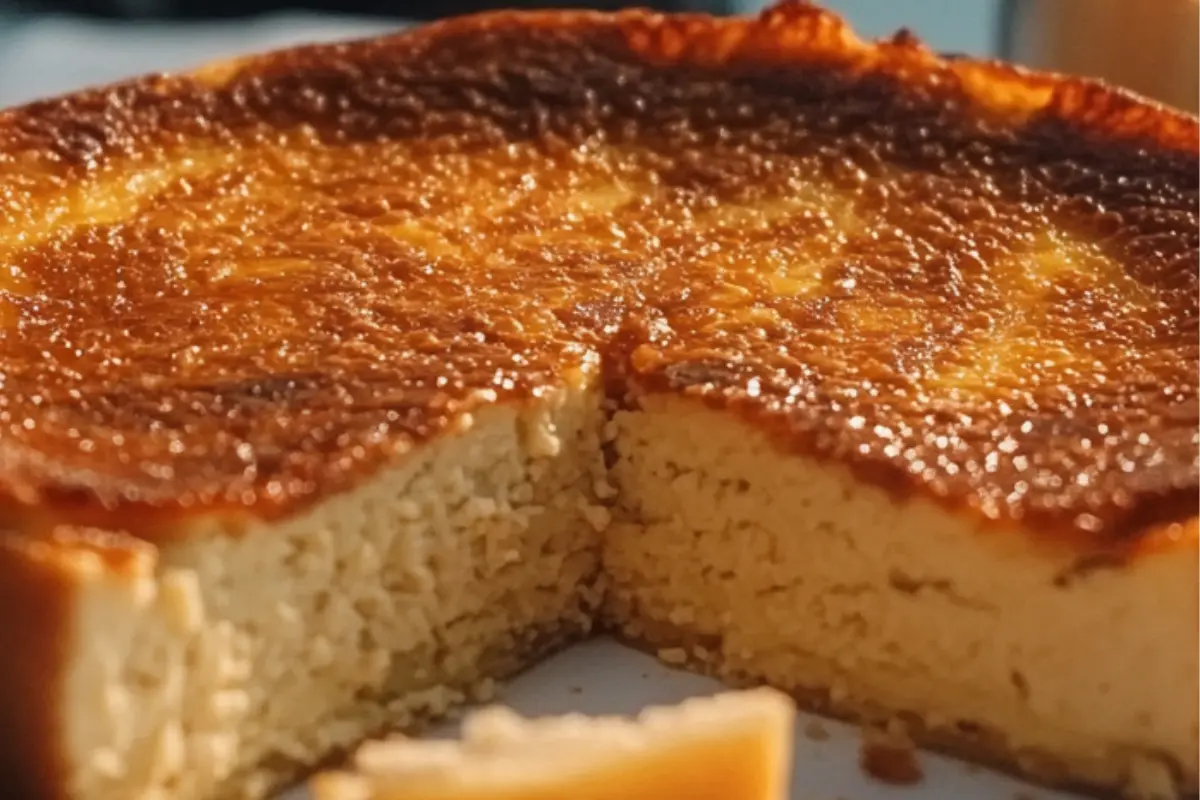Have you ever longed for a dessert that’s both comforting and unique? Look no further than the Quesadilla. This quesadilla salvadoreña recipe is not your typical savory. Instead, it’s a sweet and cheesy pastry that’s a beloved staple in El Salvador. It is often enjoyed with coffee or as a special treat.
This recipe might sound unusual. However, it’s surprisingly easy to make at home. With simple ingredients and straightforward steps, you can create an authentic quesadilla. Therefore, you can experience a true taste of Salvadoran culture right in your kitchen.
Why This Quesadilla Salvadoreña Recipe Is a Must-Bake
Firstly, this quesadilla salvadoreña recipe is a must-bake because it offers a unique and delicious flavor profile. Unlike anything you’ve probably tasted before, the combination of cheese and sweetness is unexpectedly delightful. Secondly, it represents a genuine taste of Salvadoran culinary tradition. Moreover, it’s much simpler to prepare than many other traditional pastries.
Furthermore, the aroma of baking quesadilla salvadoreña is simply heavenly. In addition, the warm, slightly tangy, and sweet flavors are incredibly comforting. Consequently, this quesadilla is perfect for sharing with family and friends, or simply enjoying as a personal indulgence.
Ingredients for Your Quesadilla Salvadoreña
Before you begin, gather all your ingredients. Proper preparation ensures a smooth and enjoyable baking experience.
- 3 cups all-purpose flour
- 1 cup granulated sugar
- 1 tablespoon baking powder
- ½ teaspoon salt
- ½ cup (1 stick) unsalted butter, cold and cubed
- 2 large eggs
- 1 cup sour cream
- 1 cup queso fresco, crumbled (or other mild, crumbly cheese like farmer’s cheese or ricotta cheese)
- ½ cup milk
- 1 teaspoon vanilla extract
- Sesame seeds for topping (optional)
Step-by-Step Instructions for Making Quesadilla Salvadoreña
This recipe is divided into simple steps. Follow each step carefully for the best results.
- Preheat oven: Firstly, preheat your oven to 350°F (175°C). Grease and flour a 9×13 inch baking pan.
- Combine dry ingredients: In a large bowl, whisk together the flour, sugar, baking powder, and salt.
- Cut in butter: Add the cold, cubed butter to the dry ingredients. Then, use a pastry blender or your fingers to cut the butter into the flour mixture. Continue until the mixture resembles coarse crumbs.
- Combine wet ingredients: In a separate bowl, whisk together the eggs, sour cream, queso fresco, milk, and vanilla extract.
- Combine wet and dry: Pour the wet ingredients into the dry ingredients. Stir until just combined. Be careful not to overmix. The dough will be slightly sticky.
- Pour into pan: Pour the batter into the prepared baking pan. Spread it evenly.
- Sprinkle sesame seeds (optional): If desired, sprinkle sesame seeds evenly over the top of the batter.
- Bake: Bake for 30-35 minutes. Or bake until a toothpick inserted into the center comes out clean and the top is golden brown.
- Cool: Let the quesadilla cool in the pan for at least 15-20 minutes before slicing and serving.
- Serve: Slice into squares or rectangles and serve warm or at room temperature. Enjoy!
Tips for the Perfect Quesadilla Salvadoreña
- Use cold butter: Cold butter is crucial for creating a tender and crumbly texture. Therefore, ensure your butter is properly chilled.
- Don’t overmix: Overmixing the dough can result in a tough quesadilla. Therefore, mix until just combined.
- Use queso fresco or a similar cheese: Queso fresco provides the authentic flavor. However, you can substitute with farmer’s cheese or ricotta cheese if queso fresco is unavailable.
- Check for doneness: Check for doneness after 30 minutes. Baking times may vary depending on your oven.
- Let it cool slightly: Letting it cool slightly makes it easier to slice and serve.
Variations on the Classic Quesadilla Salvadoreña
While the classic recipe is perfect as is, you can also customize it to suit your tastes.
- Lemon Zest Quesadilla Salvadoreña: Add lemon zest to the dough for a citrusy flavor. Stir in 1-2 teaspoons of lemon zest.
- Orange Zest Quesadilla Salvadoreña: Add orange zest to the dough for a different citrus note. Stir in 1-2 teaspoons of orange zest.
- Anise Seed Quesadilla Salvadoreña: Add anise seeds to the dough for a traditional flavor. Stir in 1 teaspoon of anise seeds.
- Cinnamon Quesadilla Salvadoreña: Add ground cinnamon to the dough for a warm spice. Stir in ½-1 teaspoon of ground cinnamon.
- Raisin Quesadilla Salvadoreña: Add raisins to the dough for added sweetness and texture. Stir in ½ cup of raisins.
Serving Suggestions for Quesadilla Salvadoreña
Quesadilla is a versatile treat that can be enjoyed at any time of day.
- With coffee: Traditionally served with a cup of hot coffee.
- For breakfast or brunch: A delightful and unique breakfast or brunch option.
- As a snack: Enjoy a slice as a satisfying afternoon snack.
- For dessert: Serve as a comforting and flavorful dessert.
- Warm or at room temperature: Delicious served both warm and at room temperature.
Storing Your Quesadilla Salvadoreña
Quesadilla can be stored at room temperature for up to 2-3 days. Store it in an airtight container to maintain its freshness. You can also store it in the refrigerator for up to a week. Reheat gently in the microwave or oven if desired.
Nutritional Benefits of Quesadilla Salvadoreña
While quesadilla is a delicious treat, it’s important to be mindful of its nutritional content. Here’s a breakdown:
| Nutrient | Amount (per serving) | Notes |
| Calories | 250-350 | Varies based on serving size |
| Total Fat | 10-15g | Primarily from butter and cheese |
| Saturated Fat | 6-9g | From butter and cheese; consume in moderation |
| Cholesterol | 50-75mg | From eggs and cheese |
| Sodium | 150-250mg | Varies based on salt added and cheese type |
| Total Carbohydrate | 30-40g | From flour and sugar |
| Dietary Fiber | 1-2g | Minimal, primarily from flour |
| Sugars | 15-20g | From granulated sugar |
| Protein | 5-7g | From eggs, cheese, and flour |
| Calcium | Varies | From queso fresco; important for bone health |
Exploring Salvadoran Baking Traditions: Beyond the Savory
Quesadilla is a testament to the rich and diverse baking traditions of El Salvador. Indeed, Salvadoran cuisine is not just about savory dishes like pupusas. It also boasts a delightful array of sweet baked goods. Quesadilla, or Salvadoran cheesecake as it’s sometimes known, is a prime example. Therefore, it showcases the unique blend of flavors and techniques found in Salvadoran pastries.
Furthermore, many Salvadoran baked goods incorporate cheese. This seemingly unusual combination adds a distinctive tang and richness. In addition, ingredients like sour cream and queso fresco contribute to the moist and tender texture of quesadilla salvadoreña. Consequently, this quesadilla offers a fascinating glimpse into the sweet side of Salvadoran culinary heritage.
Insert second Photo here
Elevate Your Quesadilla Salvadoreña: Creative Touches
While the traditional quesadilla salvadoreña is already wonderful, there are ways to elevate it with creative touches:
- Dust with Powdered Sugar: After cooling, dust the top with powdered sugar for an elegant finish.
- Serve with Fruit Compote: Serve warm slices with a side of fruit compote, such as strawberry or peach.
- Add a Glaze: Drizzle a simple glaze made of powdered sugar and milk over the cooled quesadilla.
- Incorporate Spices in the Topping: Mix cinnamon or nutmeg with sesame seeds for a spiced topping.
- Serve with Whipped Cream: A dollop of whipped cream complements the quesadilla’s sweetness and cheese notes.
Troubleshooting Common Quesadilla Salvadoreña Problems
Even with a straightforward recipe, you might encounter a few common issues. Here are solutions to help you troubleshoot your quesadilla salvadoreña:
- Dry Quesadilla Salvadoreña: If your quesadilla is dry, it could be due to overbaking. Therefore, check for doneness after 30 minutes. Ensure you are using enough sour cream and butter in the dough.
- Dense or Heavy Texture: A dense texture can result from overmixing the dough. Remember to mix the wet and dry ingredients until just combined. Avoid overmixing.
- Uneven Baking: Uneven baking can be caused by an oven that’s not properly calibrated or by placing the pan in the wrong position. Use an oven thermometer to ensure accurate temperature. Rotate the pan halfway through baking for even browning.
- Not Sweet Enough: If you prefer a sweeter quesadilla, you can slightly increase the amount of sugar in the recipe.
- Cheese Flavor Too Mild: For a more pronounced cheese flavor, ensure you are using queso fresco or a similar cheese with a noticeable tang.
FAQs
- What exactly is Quesadilla Salvadoreña?
- Quesadilla Salvadoreña is a sweet and cheesy pastry from El Salvador. It’s similar to a sweet bread or cake, featuring cheese as a key ingredient. It is not a savory quesadilla.
- Can I use a different type of cheese?
- Yes, if queso fresco is not available, you can use other mild, crumbly cheeses. Farmer’s cheese, ricotta cheese, or even a mild mozzarella can work as substitutes. However, queso fresco provides the most authentic flavor.
- Why is it called quesadilla if it’s sweet?
- The name quesadilla in this context refers to the inclusion of cheese (queso) in the recipe. In El Salvador and some other Latin American countries, quesadilla can refer to sweet pastries that contain cheese, distinct from savory quesadillas.
- Can I make quesadilla salvadoreña ahead of time?
- Yes, you can make quesadilla salvadoreña ahead of time. It stores well at room temperature for a few days. It’s often even better the next day as the flavors meld.
- How do I reheat quesadilla salvadoreña?
- You can reheat quesadilla salvadoreña gently in the microwave for a few seconds or in a warm oven for 5-10 minutes. However, it’s also delicious served at room temperature.
- Can I freeze quesadilla salvadoreña?
- Freezing is not recommended as it can alter the texture of the pastry. It is best enjoyed fresh or within a few days of baking.
- Is quesadilla salvadoreña gluten-free?
- No, traditional quesadilla salvadoreña is not gluten-free as it is made with all-purpose flour. To make a gluten-free version, you would need to substitute the all-purpose flour with a gluten-free flour blend and adjust the recipe accordingly.
Conclusion: Embrace the Sweetness of Quesadilla Salvadoreña
In conclusion, this quesadilla salvadoreña recipe offers a delightful journey into the sweet baking traditions of El Salvador. With its unique combination of cheese and sweetness, it’s a pastry that’s both comforting and intriguing. Furthermore, whether you’re looking to explore new flavors, expand your baking repertoire, or simply enjoy a delicious and culturally rich treat, this recipe is a perfect choice.
So, gather your ingredients, follow the steps, and prepare to embrace the unexpected sweetness of homemade quesadilla salvadoreña. This quesadilla salvadoreña is more than just a recipe. It’s a taste of Salvadoran heritage and a celebration of culinary diversity. Happy baking!

